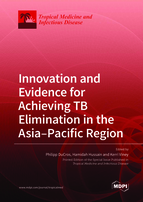Innovation and Evidence for Achieving TB Elimination in the Asia–Pacific Region
A special issue of Tropical Medicine and Infectious Disease (ISSN 2414-6366). This special issue belongs to the section "Infectious Diseases".
Deadline for manuscript submissions: closed (30 September 2020) | Viewed by 75135
Special Issue Editors
Interests: drug-resistant TB; epidemiology; implementation research
Interests: TB active case finding; TB prevention; cost-effectiveness; implementation research
Research School of Population Health, Australian National University, Canberra 2600, Australia
Interests: drug-resistant TB; research; active TB case finding; catastrophic costs; epidemiology of TB; TB elimination
Special Issue Information
Dear Colleagues,
Despite being curable, tuberculosis (TB) remains a global health emergency and one of the biggest infectious disease killers globally. Out of all TB cases globally, 62% occur in the South East Asia and Western Pacific regions. There is a need for bold action and accelerated change if the sustainable development goal (SDG) targets of 90% reduction in TB deaths and 80% reduction in TB incidence are to be met by 2030. However, barriers to TB elimination are considerable, with 30% of people with TB globally not diagnosed, only one third with multidrug-resistant TB accessing appropriate treatment, and anywhere between 27% and 83% of people with tuberculosis encountering catastrophic costs. Currently, most high-burden countries and the world as a whole are not on course to reach the targets. There is the need for new tools and better evidence on how to achieve TB elimination.
While the challenges for TB elimination remain large, there is much cause for hope with improved all oral MDR-TB treatments, a richer pipeline of new TB diagnostics and vaccines, and shorter latent TB infection treatment regimens. The lancet series “How to Eliminate Tuberculosis” outlined an evidence-based approach to ending TB into 4 key areas: rethinking data management to target hotspots, active case finding and prompt treatment, treating latent TB infection, and employing a biosocial approach throughout. This Special Issue “Innovation and evidence for achieving TB Elimination in the Asia–Pacific Region” invites submissions within these four broad areas with relevance to the Asia–Pacific region. A broad range of research methodologies will be accepted, including qualitative, epidemiology, operational, implementation, and policy research, as well as other relevant approaches.
Dr. Philipp du Cros
Dr Hamidah Hussain
Dr. Kerri Viney
Guest Editors
Manuscript Submission Information
Manuscripts should be submitted online at www.mdpi.com by registering and logging in to this website. Once you are registered, click here to go to the submission form. Manuscripts can be submitted until the deadline. All submissions that pass pre-check are peer-reviewed. Accepted papers will be published continuously in the journal (as soon as accepted) and will be listed together on the special issue website. Research articles, review articles as well as short communications are invited. For planned papers, a title and short abstract (about 100 words) can be sent to the Editorial Office for announcement on this website.
Submitted manuscripts should not have been published previously, nor be under consideration for publication elsewhere (except conference proceedings papers). All manuscripts are thoroughly refereed through a single-blind peer-review process. A guide for authors and other relevant information for submission of manuscripts is available on the Instructions for Authors page. Tropical Medicine and Infectious Disease is an international peer-reviewed open access monthly journal published by MDPI.
Please visit the Instructions for Authors page before submitting a manuscript. The Article Processing Charge (APC) for publication in this open access journal is 2700 CHF (Swiss Francs). Submitted papers should be well formatted and use good English. Authors may use MDPI's English editing service prior to publication or during author revisions.
Keywords
- Tuberculosis
- Elimination
- Active case finding
- TB infection/latent TB
- Epidemiology
- Drug-resistant TB









